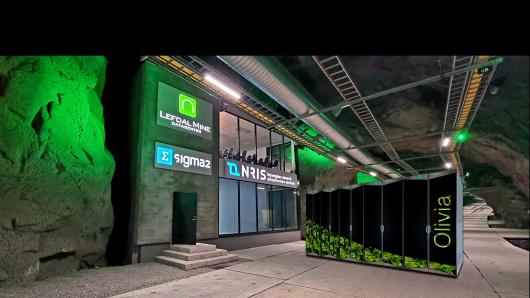Sigma2 is pleased to announce that Norway's next supercomputer now has its official name: Olivia. Olivia will play a significant role in developing artificial intelligence (AI), especially in developing and improving Norwegian language models.

With a total of 304 of the most advanced GPUs on the market, Olivia will offer a computational capacity that is 17 times greater than what is currently available nationally.
"With Olivia, we are providing researchers in Norway with a technological powerhouse that will accelerate the development of AI and machine learning. Additionally, Olivia will open the door to scientific breakthroughs in other fields, such as health, marine, and climate research," says Jenny Amundsen Ask, Product Manager for the HPC services at Sigma2.
From industry to technology
Olivia will be installed during the spring of 2025 at Lefdal Mine Data Centers near Nordfjordeid in Western Norway. The name Olivia refers to the mineral olivine, previously extracted from the old Lefdal mine, now converted into a state-of-the-art data centre. The name ties together the transition from traditional industry to advanced technology. The data centre is also operated sustainably, focusing on sustainable energy and environmentally friendly operations, which is especially important for supercomputers requiring enormous power.
As supercomputers are becoming physically smaller, they are becoming more powerful and faster, thanks to technological advancements in microprocessor and chip technology, more efficient cooling systems, and architecture optimisation.
Currently, the three supercomputers Betzy, Saga, and Fram are in national service. A national supercomputer means that researchers from all over the country can use it, regardless of which research institution they belong to.

Olivia will be significantly smaller than Betzy, Norway's most powerful machine to date. While Betzy weighs 30 tons, Olivia will weigh less than half but have a performance that is three times greater and a power consumption that is 30 percent lower.
Hewlett-Packard Norway won the contract in May this year, valued at a total of 225 million NOK.
Still not enough computing power
A recently published report from the Research Council of Norway recommends investing 2.6 billion NOK in high-performance computing for research and AI over the next five years. The report points out that generative artificial intelligence contributes to an enormous increase in the need for high-performance computing and the importance of having supercomputers located in Norway for security, preparedness, and access to necessary expertise.
"Ensuring sufficient computational capacity is crucial for our research environments in both academia and industry. Sigma2 is committed to ensuring that Norway not only keeps up, but also takes a leading role in ensuring satisfactory infrastructure. Although Olivia provides a significant boost, she only covers a small part of the need. It is urgent to invest in more computing power to stay abreast of developments," says Gunnar Bøe, Managing Director of Sigma2.
Technical specifications
- System: HPE Cray Supercomputing EX
- CPUs: 252 nodes
- Each node equipped with two AMD Epyc Turin CPUs
- Each CPU consists of 128 cores
- Total of 64,512 CPU cores
- GPUs: 76 nodes with GPUs
- Each node has four NVIDIA GraceHopper Superchip (NVIDIA GH200 96 GB)
- Total of 304 GPUs
- Interconnection: HPE Slingshot Interconnect
- Storage system: HPE Cray ClusterStor E1000
- Capacity of 5.3 petabytes (PB) storage
- Cabinets:
- 2 HPE Cray Supercomputing EX4000 DLC cabinets
- 1 CDU (cooling unit)
- 1 DLC cabinet (separate HPC test system)
- 1 Data storage cabinet (air-cooled, in POD)
- 1 River cabinet (air-cooled, in POD)
- 1 TDS River cabinet for test system (air-cooled, in POD)
- Expansion possibilities:
- Possibility for expansion to 119,808 CPU cores and/or 224 GPUs